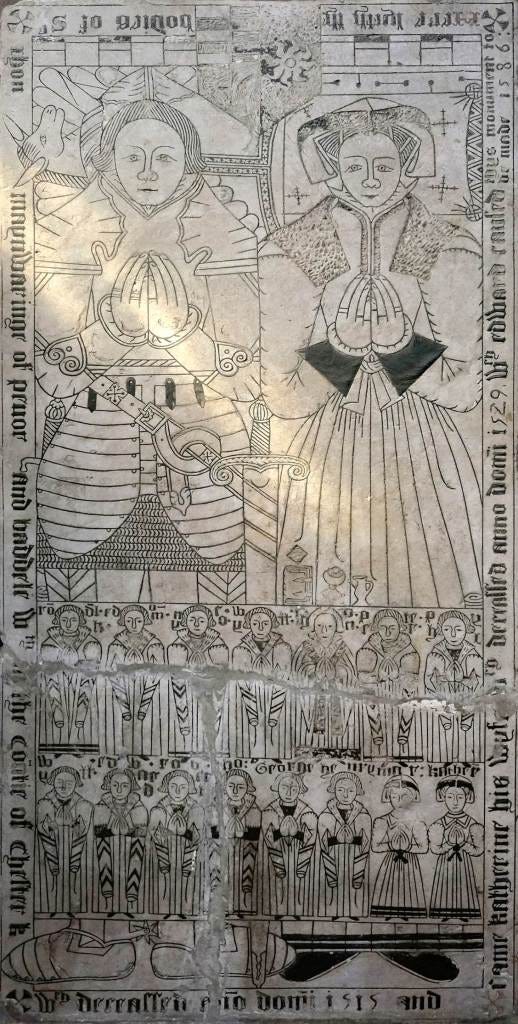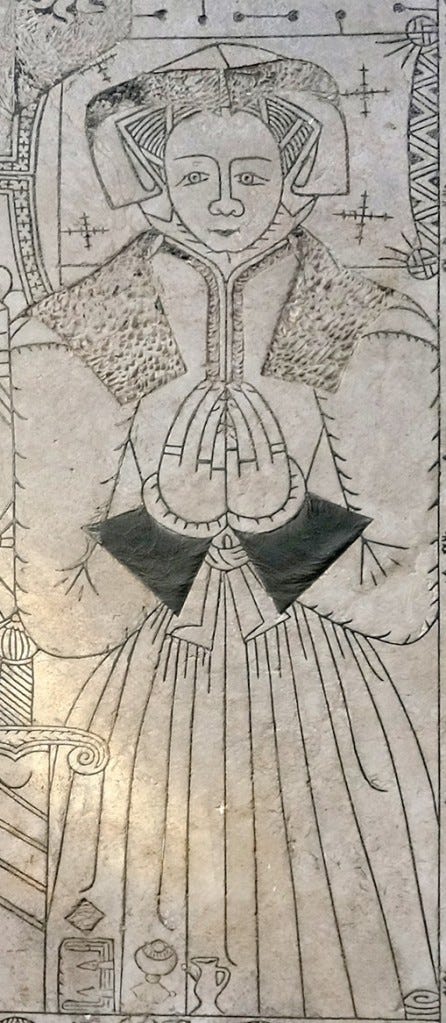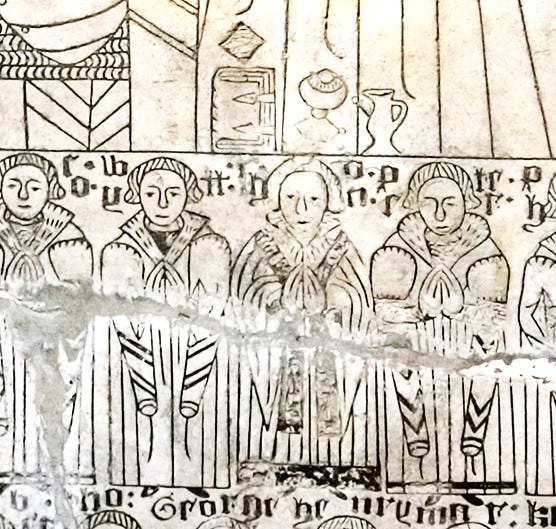One of my 13th great grandmothers (I have, at a maximum, 16,384, and so do you) was a Cheshire woman born about 1471 named Katherine Honford. Honford, now called Handforth, is about ten miles south of Manchester. Katherine was the daughter of John Honford, who also spelt his name Hondford or Hanford, and Margaret Savage. He died about 1479 and Katherine’s mother married again, to Sir Edmund Trafford of Wilmslow, two miles from Handforth.
About 1497 Katherine, then eighteen years old, married John Mainwaring of Over Peover, Cheshire, ten miles south of Wilmslow. In nineteen years they had fifteen children. John Mainwaring died in 1516 and Katherine died in 1529.
Fifty-seven years later John and Katherine’s son Edward erected a memorial to them.

Inscription
Here lyeth the bodies of Sr Jhon Maynwaringe, of Pever, and Badyley, wthin the countie of Chester, kt. wch deceassed an’o Dom’i 1515, and dame Kathrine his wyfe wch deceassed an’o Dom’i 1529, wch a Edward caused this monument to be made 1586.
The memorial was an incised slab of alabaster, commissioned from Richard and Gabriel Royley, father and son alabasterers of Burton upon Trent, Staffordshire.
The Royleys had made a similar monument at Peover for Katherine and John Mainwaring’s son Philip who died in 1573. That memorial was commissioned not long after Philip’s death.
In 1580 Edward Mainwaring of Whitmore, my twelfth great grandfather, commissioned an incised alabaster slab following the death of his wife Alice in 1576.

Shortly before his death in 1586 Edward commissioned the Royleys to create a monument honouring his parents. This shows the 15 children of John and Katherine.
Incised slabs
The term ‘incised slab’ is a memorial with an effigy of the deceased, a cross, or other appropriate subject cut directly into the stone. It had some of the features of a monument in brass, but was cheaper, and much cheaper than a raised tomb.
Alabaster is a is a sort of soft marble. The engraved representations were not portraits, and features were invariably represented conventionally.
Depiction of Katherine
Women’s fashions of the early 16th century consisted of a long gown, usually with sleeves, worn over a kirtle or undergown, with a linen chemise or smock worn next to the skin.
Katherine’s gown has a high round neck, with small ruff above; it opens apparently from neck to waist, with tight sleeves ending in a turn-back cuff supplemented by small ruffles. She has a small sash at her waist.
She wears a partlet, a 16th-century fashion accessory: the partlet was a sleeveless garment worn over the neck and shoulders, either worn over a dress or worn to fill in a low neckline. Katherine also has a small shoulder cape.
Katherine’s headdress is a Gable hood, an English woman’s headdress of about 1500–1550, so called because its pointed shape resembles the architectural feature of the same name. Lappets, decorative side panels, are doubled back and pinned up on top, with a veil cast horizontally over the peak at the front.
Katherine’s two daughters are portrayed in similar dress.
Katherine’s husband is portrayed wearing armour. His head is resting on a donkey, which seems odd. The Mainwaring crest, however, features the head of a donkey, and accounts for the animal’s presence on the memorial.
Twelve of the thirteen sons are dressed alike in long robes with long sleeves. The sleeves are of various lengths; the sleeve length perhaps an indication of their age at death. The fifth son, John, is depicted as a member of the clergy in a surplice and stole; above him are a clasped volume, surmounted by a diamond-shaped object, a chalice and wafer, and a flagon.
The incised alabaster memorial is a modest and rather initmate commemorative marker. Five hundred years after his parents’ death Edward’s small act of filial piety keeps their names alive.
Related posts and further reading
Greenhill, F. A. (Frank Allen) (1976). Incised effigial slabs : a study of engraved stone memorials in Latin Christendom, c.1100 to c.1700. Faber and Faber, London. volumes 1 and 2
Thornber, C. Photographs of over Peover, Cheshire, England, UK, and Mainwaring family. Eight Sites by Craig Thornber. https://www.thornber.net/cheshire/htmlfiles/peover.html
Wikitree: Katherine (Honford) Mainwaring (1471-1529)
1. Anne is the daughter of Rafe Champion de Crespigny
2. Rafe is the son of Kathleen Cavenagh (Cudmore) Symes (1908-2013)
3. Kathleen is the daughter of Kathleen Mary (Cavenagh) Cudmore (1874-1951)
4. Kathleen is the daughter of Ellen Jane (Mainwaring) Cavenagh-Mainwaring (1845-1920)
5. Ellen is the daughter of Gordon Mainwaring (1817-1872)
6. Gordon is the son of Rowland Mainwaring (1782-1862)
7. Rowland is the son of Rowland Mainwaring (1745-1817)
8. Rowland is the son of Edward Mainwaring (1709-1795)
9. Edward is the son of Edward Mainwaring (1681-abt.1738)
10. Edward is the son of Edward Mainwaring (1635-1703)
11. Edward is the son of Edward Mainwaring (1603-1674)
12. Edward is the son of Edward Mainwaring (1577-1647)
13. Edward is the son of Edward Mainwaring (abt.1544-1604)
14. Edward is the son of Edward Mainwaring (abt.1506-1586)
15. Edward is the son of Katherine (Honford) Mainwaring (1471-1529) (Commissioned the monument)
This makes Katherine the 13th great grandmother of Anne.




Quite some research must have gone into all that. Well done!
15 children in 19 years! Oh dear. I loved reading this early history story and love the memorial. I appreciate your description of Katherine's clothing as I have an interesting in the history of fashion.